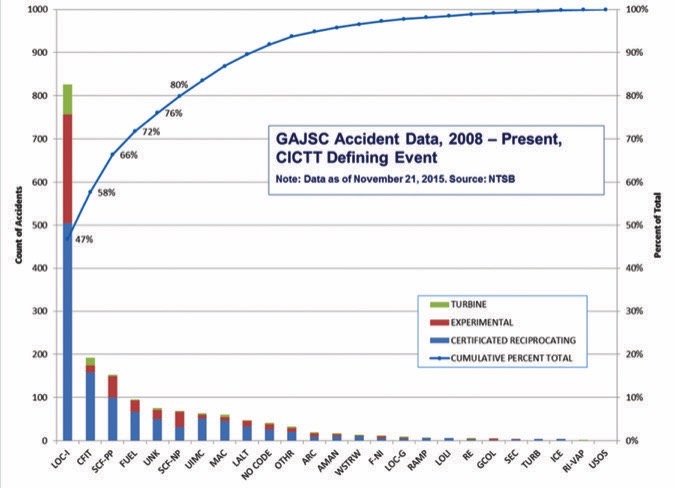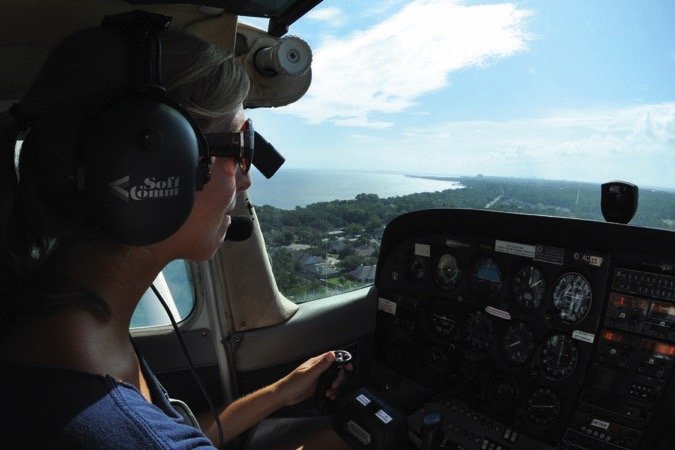Since the mid-1990s, the FAA has worked proactively with the aviation community to reduce fatal aviation accidents. This has worked spectacularly well with the airlines, which are much more tightly regulated than general aviation, and the safety record shows it. Until recently, however, these efforts haven’t trickled deep down to GA. That’s changing.

Recent, similar efforts involving the FAA and the GA community are picking up in tempo. You’ve already seen some of the institutional changes: relaxed certification standards for installing advisory angle-of-attack indicators and the new rash of all-electronic attitude indicators, among others, which are designed to help minimize the classic loss-of-control inflight accident. These and other outcomes may be producing tangible results, but it’s too early to be sure. Regardless, by using a data-driven approach and producing specific safety enhancements, these efforts are creating some useful outcomes for GA pilots. The way this came to be is an example of why you never want to see sausage made.
‘Safer Skies’
The FAA’s move away from of its traditional role of “enforcing the regulations” really began after a spate of airline accidents demonstrated that merely complying with the regulations was not sufficient to ensure safety. The most spectacular of these was the July 17, 1996, loss of TWA Flight 800, a Boeing 747 that exploded in mid-air south of Long Island, N.Y., which was preceded by the May 11, 1996, crash of ValuJet Flight 592, a McDonnell Douglas DC-9, which plunged into the Florida Everglades after an in-flight fire broke out in the cargo hold, disabling flight controls.
I remember ValuJet 592 well, since I was working in FAA headquarters then and was tasked with leading the Flight Standards headquarters team that was managing the accident at one end of the food chain, while a separate NTSB/FAA field team investigated the accident site. The politics of this accident generated a major political storm and, as one result, my boss and his boss eventually lost their jobs.
Within the confines of the FAA’s Flight Standards, the ValuJet 592 accident generated much hand-wringing about how the FAA should do its safety oversight job. After the accident, I watched for weeks as we tried to find some regulations that the airline violated. They seemed to comply with the minimum standards of the regulations and it took about a month to find a violation forcing the agency to suspend their operating certificate.
Some of us already knew that mere compliance with the regulations is a necessary but insufficient action to ensure safety. Flight Standards eventually devised a long-term strategy based on a “system safety” concept that would require proactive cooperation with the community, rather than enforcement, and be data and risk-driven.
While Flight Standards was moving slowly, the aviation community and new FAA leadership responded rapidly to political pressure by creating the “Safer Skies” initiative. This concept envisioned the FAA and industry working together to use data to proactively identify accident precursors and then devise mitigations using non-regulatory approaches and risk-based methods.
CAST
The airline community quickly jumped on the bandwagon and in partnership with the FAA created the Commercial Aviation Safety Team (CAST) by 1998. Besides the airlines, the group included manufacturers, pilot unions, FAA offices and other industry organizations. They quickly settled on a data-based analysis taxonomy and started to review accident and other data to determine leading accident causes and precursors. From this analysis they surfaced leading accident “causes,” such as loss of control (LOC), controlled flight into terrain (CFIT) and others.
The CAST efforts were rewarded by a spectacular reduction in airline accidents. For example, from 1998-2008, the fatal airline accident rate in the U.S. declined by 83 percent. Yes, there were other factors involved in this reduction, but the CAST effort pioneered the kinds of activity that could influence accident rates. That’s due, at least in part, to the tightly controlled and managed airline world, where it is relatively easy to implement widespread changes.
The efforts of the CAST, including the proactive way it formed, were recognized within the aviation community. In 2008, the group was awarded the prestigious Collier Trophy.
GAJSC
What about the general aviation community? Even though the tragic airline accidents of the mid-1990s did not put GA in the spotlight, the FAA and general aviation groups agreed that an effort similar to CAST was needed. After all, the fatal accident rate for general aviation in 1996 was about 40 times that of scheduled U.S. air carriers. The GAJSC was finally organized in 1997 and began to target specific safety issues.
The data analysis methodology used by the GAJSC was somewhat different than that used by the CAST. One thing they did was concentrate efforts to improve the quality of GA safety and accident data, which was nowhere near the quality of airline accident data. Nevertheless, the GAJSC produced several reports in the early 2000s on safety issues such as weather, CFIT and runway incursion accidents, as well as a report on aeronautical decision making.
And there they sat.

FITS
After a flurry of these reports were issued in the 2000-2002 timeframe, very little was done to produce tangible mitigations for GA accidents. As the GAJSC’s initial activity tapered off, I became the FAA executive leading the General Aviation and Commercial Division and was determined to tackle the GA safety issues raised by the GAJSC. My own analysis convinced me that the general aviation training system was a key impediment to improving safety. The traditional GA training paradigm centered around rote learning, was maneuver-based, depended largely on spoon feeding by the instructor, and did not emphasize advanced pilot skills such as single-pilot resource management (SRM). Consequently, I initiated the FAA Industry Training Standards (FITS) program.
The FITS initiative was designed to research and implement new training concepts such as scenario-based training, student-centered learning and grading, and SRM proficiency, especially risk management. In designing the program, I created partnerships with the leading universities with aviation training programs. Among the products that were researched, developed, and tested was an integrated private/instrument curriculum and course.
The research and hands-on real-world testing of FITS proved the embodied concepts were effective. Pilots trained with them performed as well or better than those trained by conventional methods, and performed much better with tasks such as automation management and other SRM elements.
General aviation accident rates remained flat.
The Community Responds
After I retired from the FAA in 2005, progress on FITS slowed as the organization I led went through three successive leadership changes in five years. Meanwhile, the general aviation fatal accident rate was stagnant, even as the airline rate continued its decline toward zero.
In late 2010, I decided it might be time to highlight the need for pilot training reform, and to “reinvigorate” FAA and industry action. With several other fellow members of the Society of Aviation and Flight Educators (SAFE), we organized a pilot training reform symposium, held in Atlanta, Ga., in May 2011. The symposium was well attended by FAA and industry leaders, and practitioners in the training community, and was keynoted by then-FAA Administrator Randy Babbitt. We organized these talented individuals into three work groups and tasked them with creating real-world recommendations for training reform before the end of the symposium.
The event produced many recommendations concerning training standards, doctrine, curricula and other elements of modernized training. We transmitted the final report on the symposium to offices in the FAA and several general aviation organizations.
The symposium attracted a lot of aviation press attention, and the FAA took notice. Within a few months, action to address symposium recommendations was underway on at least two fronts within the FAA and its partners in the general aviation community.
In late 2011, the FAA chartered the first of three work groups under the aviation rulemaking advisory committee umbrella to examine pilot training standards and recommend changes to those standards to address accident causes and other safety issues. I still serve on the third of these three groups, which is finalizing the airman certification standards (ACS) replacing the practical test standards (PTS). The private and commercial pilot as well as the instrument rating ACS documents are currently effective. Other airman certificate ACSs will be issued until all PTS documents are eventually replaced.
Also in 2011, the FAA re-chartered and reorganized the GAJSC to identify GA accident causes and develop safety mitigations. The GAJSC was directed to use data analysis methods like those used by the CAST and to develop practical, effective “safety enhancements” (SEs) designed to mitigate general aviation safety problems. Since then, the GAJSC has been busy analyzing accident data, issuing reports on major accident causes, and developing mitigations outlined in the SEs. Their analysis developed, among other data, the infographic reproduced on the opposite page.
It’s important to point out that the GAJSC relies on NTSB reports and reporting conventions. In my view, these don’t always reveal the true root causes of accidents. For example, accidents attributed to LOC-I and CFIT often are describing only the final event in the accident chain that produced the “smoking hole” in the ground. They don’t usually describe the “why” of the accident.
Improving trends?
Speaking of hype, some in the GA press and community have been touting the reduction in GA fatal accident rates that occurred in 2015 and 2016. For example, the rate per 100,000 flight hours dropped from 1.305 in 2014 to 1.098 in 2015 and dropped again to 0.989 in 2016. Much has been made about how GA has finally cracked the barrier of one accident per 100,000 hours and perhaps how this is due to GAJSC or other FAA/industry accidents.
If these numbers truly indicate a sustainable new trend in GA safety is underway, it’s clear that would be a good thing. But I would be cautious about attributing cause and effect when describing actions taken by the GAJSC or, for that matter, any other recent actions by the FAA, industry or the aviation community.
For example, it could be that the accident rates are decreasing because of the sad demographics of general aviation. In the last 35 years, the number of private pilots has decreased drastically—and the number of student pilots and student starts even more so. This means that the percentage of low-time pilots in the system has fallen to its lowest level in years. The historical record shows that pilots in training have relatively good safety records because they are under an instructor’s supervision and that accident rates go up after these pilots receive private certificates, until they gain more experience. While I’m not yet buying this hypothesis, I believe we should remain skeptical about accident trends and even more so about showing cause and effect due to recent FAA and industry actions.
(Readers should know that this magazine’s Editor-in-Chief actively participated in the GAJSC’s efforts to identify safety enhancements designed to mitigate accidents resulting from powerplant failures.)
Where’s the Beef?

So where does any of this leave individual pilots who are looking to the GAJSC or other organizations for information that will help them fly safer and avoid accidents? To answer that question, we might want to look at a few of the safety enhancements (SEs) produced by the GAJSC to see which ones might provide useful and practical information. Below are a few of my favorites that may meet that need.
You may find other SEs that may be more relevant to your own operations. In most cases, however, you will find that the SEs are new enough that follow-up action has not yet occurred and there is no “product” in place that will give you the information you need to take leverage the SE. Hopefully, in time the FAA and the GA community will fully implement those SEs that will be of most value to pilots.
Risk-Based Flight Review: “The FAA will compile and disseminate risk-based concerns to flight instructors and flight schools to highlight regional and national risks in training and flight reviews. National risk-based concerns identified by the GAJSC in studies for that year should also be shared.”
Weather Technology/Use of Available Weather Information: “The FAA and industry will educate the GA community on and promote the use of available weather information technologies, such as the National Oceanic and Atmospheric Administration (NOAA) Aviation Digital Data Service (ADDS) icing tool.”
Single-Pilot CRM: “Best practices regarding single-pilot CRM will be identified. The identified best practices should be communicated to the GA community through a public education campaign.”
For More Information
– For those readers so inclined, all of the GAJSC’s reports, including those dating from its early years, are still available and can be accessed online at the organization’s web site:www.gajsc.org/document-center/
– Readers who may want more information on the FAA Industry Training Standards (FITS) program, various documents are still on the FAA web site at: www.faa.gov/training_testing/training/fits/research/.
– Information on SAFE’s May 2011 symposium is available on that organization’s web site at: www.pilottrainingreform.org.
– The GAJSC’s safey enhancements (SEs) also are available online: www.gajsc.org/safety-enhancements/.
– Additional details on the GAJSC can be found in my earlier article on the organization and its work in the March 2011 issue of Aviation Safety.
Robert Wright is a former FAA executive and President of Wright Aviation Solutions LLC. He is also a 9800-hour ATP with four jet type ratings, and he holds a Flight Instructor Certificate. His opinions in this article do not necessarily represent those of clients or other organizations that he represents.




